 |
|

|
 |
TABLE of CONTENTS
 |
MnDOT's new slip simulator: Coming soon to a location near you |
By J.P. Gillach
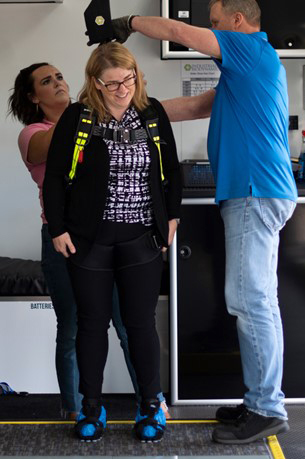
Sheila Kauppi, MnDOT Metro District deputy engineer, dons a pair of slider shoes and a safety harness to prep for her first walk on MnDOT's new slip simulator July 11 at MnDOT's Arden Hills Training Center. Assisting are Haley Eustice, District 7 trainer, and international slip simulator trainer Jim Kleinsteuber. Photo by Rich Kemp |
MnDOT recently purchased a mobile slip simulator that will give staff the opportunity to train their bodies and minds to better react when they have to walk on a slippery surface. The training has been shown to significantly reduce on-the-job injuries at other organizations.
“The most common injury to MnDOT employees involves a slip and fall,” said Jay Hietpas, MnDOT assistant commissioner, operations. “At least 282 people were injured on the job by a fall in the last three years, and those injuries occur whether you work in an office, in a shop or in the field. If the simulator training works as well here as at other organizations, we’ll make a huge leap forward in on-the-job safety.”
The simulator itself consists of a slippery surface, special slider shoes and a personal harness mounted to an overhead sliding support system to keep trainees safe from falling. The entire apparatus is housed inside a 30-foot trailer that opens up to provide a viewing area to train observers as well as participants. During training, the slippery surface is made even more slippery with a mixture of soap and water.
“The idea behind the simulator is to teach somebody a new way to navigate off of a slippery surface they are not prepared for,” said Jim Kleinsteuber, a contractor who conducts slip simulator training around the world and led the MnDOT training session on July 11. “The coefficient of friction with the soap, the shoes and the floor is zero. So, it’s as slippery as anything you’ll ever walk on, and it’s introducing a new technique. Once they get in there, we do a couple of sit tests to make sure they’re comfortable in the harness. And then we send them out on the floor. We start with normal walking. Then teach a new technique.”
The simulator was invented by Dr. Thurmon E. Lockhart at Virginia Tech University for United Parcel Services, and Kleinsteuber noted that “In the first year of implementation, [UPS] saw their slip, trip and fall rates drop 60 to 70%.”
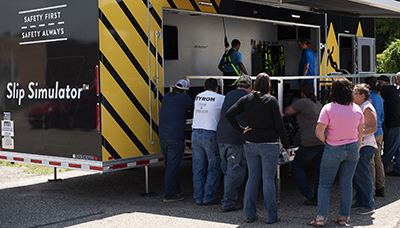
A slip simulator "train the trainer" session occurred at MnDOT"s Arden Hills Training Center July 11. Photo by Rich Kemp |
“This is important training, particularly in our climate,” said Hietpas. “We’d like everyone to take the training within the next 18 to 24 months. Of course, we also recognize that not all employees will feel comfortable going through the slip simulator. If that’s the case, we ask that you come watch the simulator and learn how to walk using the proper techniques with some ground-based training.”
“We’ve already received a lot of positive feedback from MnDOT employees who’ve participated in this training in its first few weeks,” said Karin van Dyk, MnDOT assistant commissioner, workforce and agency services. “There is a lot of interest and anticipation, it’s new and interesting, but most importantly we’re hearing that this really does help make a difference.”
A slip simulator “train the trainer” session occurred at MnDOT’s Arden Hills Training Center July 11, and the simulator is now being deployed around the state. The slip simulator and training is scheduled to visit every MnDOT District before the end of the year during the following periods:
- D7 – week of Aug. 14 (already completed)
- D6 – week of Aug. 21
- D8 – week of Aug. 28
- D4 – week of Sept. 5
- D3 – week of Sept. 11
- Metro and Central Office – Sept. 18 through Oct. 13
- D2 – week of Oct. 16
- D1 – week of Oct. 23
To learn more about the simulator, contact Don Baker, Mankato subarea supervisor and acting statewide slip simulator coordinator, at donald.baker@state.mn.us or 507-720-5673. More information is also available on the Inbiodyn.com slip simulator webpage. |
| |
|

|
 |
TABLE of CONTENTS
 |
Crews give new life to "golden stripe" |
By Doug Mack
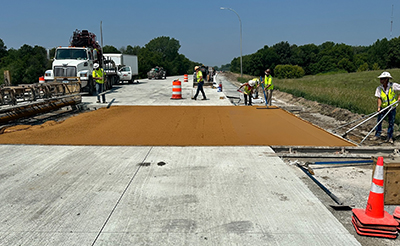
Crews install the "golden stripe" across I-90 near Blue Earth.
Photo by Robert Sneller, District 7
|
A lesser-known Minnesota landmark will soon come back to life, as MnDOT crews work to restore the “golden stripe” across I-90 near Blue Earth.
The tinted-concrete stripe debuted in 1978, as the final piece of I-90, which runs more than 3,000 miles from Seattle to Boston. Some 2,500 people attended the ribbon-cutting, which featured a flyover by National Guard jets and a cameo by the 56- foot-tall Jolly Green Giant statue, which was on its way to its permanent home just down the road. The eye-catching hue, and the name, are an homage to the golden spike in Utah, which marks the spot where the transcontinental railroad came together in 1869.
Though the I-90 panels had survived the wear and tear of millions of vehicles for decades, by 2006 this stretch of interstate was crumbling and had to be repaved. At the time, most of the golden panels were paved over, with only the shoulders left untouched.
Now, as part of the 2023-24 I-90 construction project, MnDOT is reestablishing the stripe in the original locations. Crews installed the panels on the westbound lanes on July 24, and will install the stripe on the eastbound lanes in 2024.
“The community’s pride in the gold panels on I-90 has made their restoration so much more rewarding,” said Victoria Nill, assistant district engineer for construction. “It’s made a simple unbonded overlay into a project with something a little extra. It’s not only providing a smooth driving surface that the community was excited about, but reestablishing the panels also adds something that has real meaning and importance to them. It’s putting back a reminder of the significance of the completion of I-90, the longest interstate in the United States.” |
| |
|

|
 |
TABLE of CONTENTS
 |
MnDOT begins using Wireless Emergency Alerts to improve traveler safety |
|
By Anne Meyer
MnDOT has a new way to alert motorists about road closures and other emergencies on the highway. The agency has entered into an agreement with the Federal Emergency Management Agency to begin using Wireless Emergency Alerts through the Integrated Public Alert & Warning System, which is FEMA’s national system for local alerts to share emergency information to the public.
WEAs use the same system that shares critical notifications like AMBER alerts with the public, as well as other time-sensitive information during natural disasters or threats to public safety. WEAs provide the ability to send alerts directly to mobile devices without the user needing to download an app or subscribe to a service. State departments of transportation in Pennsylvania, Georgia and Texas have successfully used WEAs for major road closure alerts, and many local county sheriff’s offices in Minnesota have authority to use the system as well.
“The ability to send WEA messages through IPAWS is an important additional tool for MnDOT to provide real-time information to the traveling public,” said Commissioner Nancy Daubenberger. “Road closures can occur suddenly, especially in cases of severe weather or major crashes on the highway system. With WEA messages, MnDOT will be able to send immediate mobile alerts to people in the vicinity of a highway closure or detour – helping minimize motorists on roadways during winter conditions and aiding law enforcement and emergency personnel in responding to incidents quickly.”
The WEA alerts will typically include a link to 511mn.org for more information, and a simple description of the closure or incident. As an example, a message might look like this:
“EMERGENCY ALERT – The I-90 corridor is closed from the South Dakota border to Albert Lea due to blizzard conditions. Go to www.511mn.org for more information and updates.”
MnDOT’s operating procedures include sending emergency alerts only when highway closures of more than four hours are expected due to weather (such as snow, ice or flooding) or major crashes or incidents. MnDOT alerts will only be sent for closures on state highways and interstates under the agency’s jurisdiction and will be sent to all mobile phones within a one-mile band around the highway, beginning 10 miles ahead of any closure location. The nature of an emergency could require a larger area for notifications, and specifics will be determined on a case-by-case basis.
|
| |
|

|
 |
TABLE of CONTENTS
|
State Fair booth to offer activities, information |
By Doug Mack
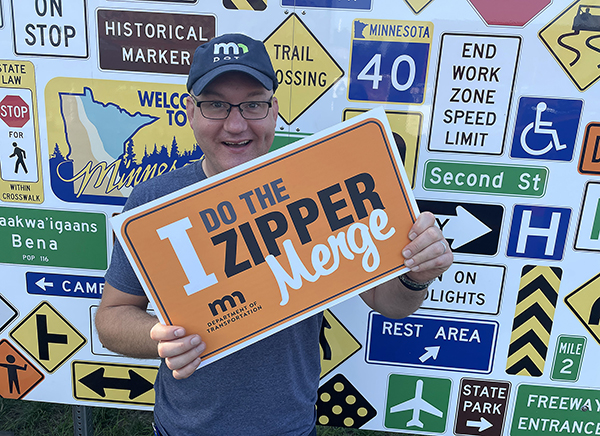
MnDOT will return to the Minnesota State Fair, which opens on Thursday, Aug. 24 and runs through Labor Day, Sept. 4. The agency's booth will be on Cosgrove St., directly across from the entrance to the Education Building. Booth highlights will include the snowplow Plow Bunyan, a selfie wall with an array of road signs and a new a beanbag-toss game that visitors can try while wearing googles that simulate different levels of intoxication, helping to demonstrate the dangers of driving while impaired. More than 150 agency employees have signed up to work at the fair, answering questions and providing information to visitors. Joseph Palmersheim, Office of Communications & Public Engagement, tried out the selfie wall while helping to set up the MnDOT booth. Photo by Anne Meyer
|
|
|

|
 |
TABLE of CONTENTS
 |
Staffing Updates |
Andrew Lawver named new bridge construction and operations manager
Andrew Lawver has accepted a one-year mobility assignment as bridge construction and operations manager for the Bridge Office, effective Aug. 16. He will provide overall leadership and direction to the Bridge Construction and Operations section in the Bridge Office, which includes construction, scoping, fabrication methods, structural metals, load ratings, safety inspections and bridge asset management.
Lawver began his career at the agency in 1990 as a student worker at the MnDOT Traffic Management Center. After finishing his studies and then working in South Dakota and China for several years, he rejoined MnDOT in 2012, starting as a graduate engineer in District 7.
Nate Blanchard named new preliminary bridge plans engineer

|
Nate Blanchard has taken on a new role as preliminary bridge plans engineer in the Bridge Office, effective August 16. He will manage, direct and administer the Preliminary Bridge Plans Unit, which provides MnDOT with technical expertise in selecting the most appropriate and economical type of bridge structure for each bridge construction project statewide and prepares Preliminary Bridge Plans to document those decisions.
Blanchard first worked at MnDOT in the late 1990s as a student worker while studying at North Dakota State University. After working in the private sector for more than 20 years, he rejoined MnDOT, where he has spent the last five years working in the Bridge Office in the Preliminary Plans Unit.
|
| |
|

|
 |
TABLE of CONTENTS
 |
New library materials available |
By Madeline Kuncio, MnDOT Library
The latest issue of New Library Materials is available. This issue highlights the book The Death of Demographics: Valuegraphic Marketing for a Values-Driven World by David Allison.
New Library Materials is a compilation of resources added to the library collection during the previous month. Visit the MnDOT Library website and click New Library Materials to sign up. Questions and feedback are welcome at Ask a Librarian. |
| |
|

|
 |
TABLE of CONTENTS
|
On the Job: Donovan Miles leaves no stone unturned in aggregate testing |

Donovan Miles, geologist, works on aggregate testing at the Maplewood Materials Lab. Photo by Joseph Palmersheim
|
By Joseph Palmersheim
Donovan Miles is a geologist with Materials and Road Research. He’s worked at the Maplewood Materials Lab for the past two years.
What do you do in your job?
I do quality control with a bunch of different tests to ensure the quality of aggregate products being used in road construction. Samples are dropped off at the lab from various sources around the state. We have someone who runs gradations, and then they bring me sample pans and I pick through them to make sure they are up to specifications.
A gradation is the particle size distribution of a sample of aggregate. Samples that come in are run through a shaker, which contains sieves with different size openings. The sieve openings start large and get progressively smaller. The weight of the rock retained on each sieve is recorded and can be used for a weighted average. The size distribution can give insight concerning compaction and voids. Long story short, there needs to be different size rocks to fill in gaps between larger rocks. If the aggregate was all the same size, it would be structurally weak due to the voids that are created.
I get a portion of specific sizes of these graded aggregates. I look through them to determine any potentially problematic rocks. There are certain types of rock that are considered “spalling material.” Spall is any material (aggregate) that is potentially harmful to pavement and structures. More specifically, spalling concrete occurs when hardened pieces of concrete separate, leaving rounded depressions in the surface. It is important to frequently monitor aggregate sources to uphold the structural integrity and longevity of the roads and structures that we build.
What do you find interesting about your work?
I like all the cool little stuff that you find when you are looking through rocks all day. I find a lot of agates and fossils. I have a jar of agates on my desk that I’ve had on my desk since I started.
What did you want to be growing up, and how did you get interested in geology?
When I was growing up, I wanted to be a professional athlete, like a lot of kids. Being a professional baseball player would have been great but that didn’t exactly pan out. I was always interested in working on an oil rig or maybe with animals. But when I went to college, I didn’t know what I wanted to do, and I ended up in a marketing program at the University of Minnesota Duluth. I wanted to do a science and liked to be outside. A lot of the classes I’d taken were related to geology in some way, so I went that route instead. I don’t regret it.
Do you ever go rock hunting for fun?
All the time. When I was in Duluth, I’d go on the shore looking for agates. Around the metro, I don’t get out much. But I’ll drive places.
What about rocks and minerals do you find interesting?
I like the way they look and feel. Almost everything in the world is built from some sort of rock. We live on a giant rock full of resources. I love different formations, too, and how minerals form. You can see two rocks that seem to look identical, but they are completely different.
Do you or a co-worker have an interesting job to share with readers? Send us your ideas, and we’ll contact you for more information.
Recent employee profiles:
|
 |
|

|
 |
TABLE of CONTENTS
|
GoMobile engages audiences around Minnesota |
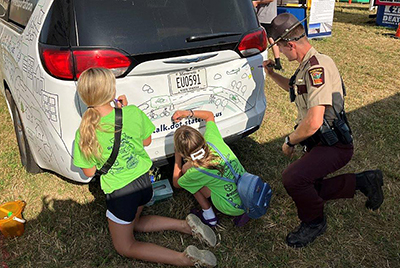
A State Trooper joins kids to draw on the GoMobile at Farm Fest. Photo by Melissa Hjelle, District 8
|
By Doug Mack
Curious onlookers may wonder what’s happening when they see people drawing on MnDOT’s GoMobile at public events, doodling and writing names on the agency-owned hybrid vehicle. But the art is precisely the point of the project – the hands-on experience is part of the fun and makes the GoMobile an effective public engagement tool.
The agency now has two of the vehicles, which feature black-and-white line drawings and graphics that provide a canvas for members of the public – kids and adults alike – to color using washable chalk markers. The second vehicle went into action in May, due to popular demand.
"Together, the two GoMobiles have been used eight times since then and they’re already scheduled for another six appearances this season, said Mai Nhia Lor, public engagement coordinator, Office of Communications and Public Engagement. “Everyone is reporting back that it does drive people to engage more with MnDOT,” Lor said.
To learn more and check out the GoMobile, visit the GoMobile page on iHUB. After a reservation is made, Public Engagement will send guidelines and procedures for using the vehicles, including how to check out the GoMobile from Central Office in St. Paul. |
 |
|

|
 |
TABLE of CONTENTS
|
Name That Place Puzzler #7 |
By Doug Mack
Can you name the place pictured below? The photo is from MnDOT staff and the satellite image is from the 511 website and app. If you’re feeling stumped, just go with your gut; don’t think twice.
If you think you know the answer, email Newsline editor Doug Mack. The first three people to submit the correct answer will receive the fame and glory of having their names listed in the next issue of Newsline.
Results from the last Puzzler: I-90 just outside Beaver Creek. More than 50 people submitted answers and nearly all of them were correct. The first three to get it right were Dave Larson (Materials and Road Research), Jeff Higgins (District 3) and Ron Heim (District 6). Congrats to them and thanks to everyone who played!
|
 |
|
|
|



